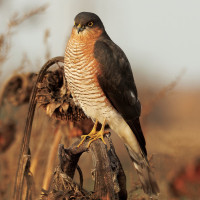Descrição
The main body of Pengelli Forest with its gently undulating topography and many small streams has developed on poorly drained boulder clay soils. The woodland – owned and described in detail in Elizabethan times by the noted Pembrokeshire historian George Owen- was once very important to the local economy as a source of timber, and was grazed by livestock that were confined within a bank and ditch. The canopy comprises a mixture of Birch, Ash and Alder with a wide range of hybrid Oaks. Over much of the site there is a dense understorey of Bramble, Hazel, Honeysuckle, Hawthorn and Holly. This is the only known location for the Midland Hawthorn in Pembrokeshire and Aspen, Goat Willow, Wild Cherry, Wych Elm and Apple are also to be found.
The range of birds is typical of such a woodland with species including Rabirruivo-de-testa-branca , Felosa-assobiadeira , Águia-d'asa-redonda , Felosa-comum , Coruja-do-mato and Gavião da Europa with Galinhola visiting in winter. These species were augmented in the 1980s by the Papa-moscas-preto , which uses nest boxes for nesting. chapim-montês , Pica-pau-malhado-pequeno and Cuco-canoro are also found on the reserve. For more information about the status of Papa-moscas-preto in Pembrokeshire check the link below.
Detalhes
Acesso
Access: Grid References O.S. Explorer map OL35 North Pembrokeshire. Main entrance: SN123396, Site centre: SN130393. See Map. The reserve is about 2.5 km from Felindre Farchog via road and lane. Limited roadside parking is available at the entrance. There are easy walks near the entrance but no wheelchair access; elsewhere paths can be muddy and steep. On the map below you find a suggested circular walk of 4 km long.
Note that the reserve is actually very close to Castell Henllys but you cannot easily access it from there.
Terreno e Habitat
Floresta , Árvores e arbustos dispersosCondições
Montanhoso , PlanoCaminho circular
Simé útil um telescópio?
NãoBoa temporada de observação de aves
Durante todo o anoMelhor hora para visitar
PrimaveraRota
Estrada não pavimentada , Caminho estreitoCaminho dificil
Caminhada médiaAcessível por
PéAbrigo/plataforma deobservação de aves
NãoInformação extra
Pengelli Forest is part of the largest block of ancient Oak woodland in west Wales. The woodland can be broadly divided into two sections. Adjacent to the entrance is Pant-Teg Wood, the steep slopes supporting woodland dominated by Sessile oak and Birch regrown from clear-felling during 1914-1930. There is a good understorey of Hazel, Holly and regenerating Oak. The ground flora is characteristic of acid Sessile Oak woodland with Wavy Hair-grass, Common Cow Wheat and Bilberry, with numerous moss species. Three trees of the native Wild Crab Apple are present and valley bottoms support Alder and Willow.



